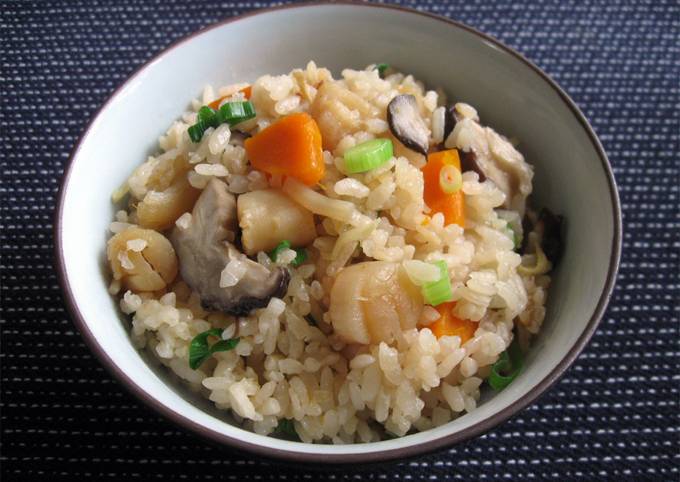Dried Scallops Takikomigohan. Soak dried Scallops in water until soft and you will have a really nice stock. Using this stock and softened Scallops, you can cook a delicious 'Takikomigohan'. Today I added Carrot and Shiitake as.
 The cream of the crop stock are mostly sold to them.
Takikomi Gohan (炊き込みご飯) is a wonderful and comforting Japanese mixed rice recipe made with seasonal ingredients.
This Instant Pot Takikomi Gohan is Japanese mixed rice with chicken and vegetable pressure cooked in a savory dashi broth.
The cream of the crop stock are mostly sold to them.
Takikomi Gohan (炊き込みご飯) is a wonderful and comforting Japanese mixed rice recipe made with seasonal ingredients.
This Instant Pot Takikomi Gohan is Japanese mixed rice with chicken and vegetable pressure cooked in a savory dashi broth.
Hey everyone, it is Brad, welcome to my recipe site. Today, I will show you a way to make a distinctive dish, dried scallops takikomigohan. It is one of my favorites food recipes. This time, I'm gonna make it a little bit tasty. This will be really delicious.
Dried Scallops Takikomigohan is one of the most well liked of current trending meals on earth. It's enjoyed by millions every day. It's easy, it is quick, it tastes yummy. They are fine and they look wonderful. Dried Scallops Takikomigohan is something that I've loved my entire life.
Soak dried Scallops in water until soft and you will have a really nice stock. Using this stock and softened Scallops, you can cook a delicious 'Takikomigohan'. Today I added Carrot and Shiitake as.
To begin with this particular recipe, we must first prepare a few ingredients. You can have dried scallops takikomigohan using 10 ingredients and 5 steps. Here is how you cook it.
The ingredients needed to make Dried Scallops Takikomigohan:
- {Make ready 50 g of Dried Scallops.
- {Take 400 ml of Water.
- {Make ready 2 cups of (*180ml cup) Japanese Short Grain Rice.
- {Prepare 1/2 teaspoon of Salt.
- {Get 1 tablespoon of Sake (Rice Wine).
- {Take 1 tablespoon of Soy Sauce.
- {Get 1 of small piece Ginger *cut into fine strips.
- {Get 1/2 of Carrot *cut into small pieces.
- {Take 2-3 of Shiitake Mushrooms *thinly sliced.
- {Make ready 2 of Spring Onions *finely chopped.
Takikomi gohan (炊き込みご飯, 炊き込み御飯) is a Japanese rice dish seasoned with dashi and soy sauce along with mushrooms, vegetables, meat, or fish. The ingredients of takikomi gohan are cooked with the rice; in a similar preparation, maze gohan. A wide variety of dried scallops options are available to you, such as variety, style. Takikomi Gohan (炊き込みご飯) is a wonderful and comforting Japanese mixed rice recipe made with seasonal ingredients.
Instructions to make Dried Scallops Takikomigohan:
- Rinse Dried Scallops and soak in 400ml cold Water for a few hours or until soft. Large Scallops should be soaked overnight..
- Wash Rice by stirring it thoroughly in water with your hand and drain the water. Repeat this a few more times until water flows through clear..
- Place it into the rice cooker’s inner pot. Drain the soaked Scallops and save the water, that is now a really good stock. Add the stock to the pot, up to the 2-cups-marking..
- Add Salt, Sake (Rice Wine), Soy Sauce and Ginger, and gently stir. Place the softened Scallops, broken into smaller pieces if large, Carrot and Shiitake over the rice evenly. Press ‘COOK’ button to start cooking..
- When the rice is cooked, let it steamed for 10 minutes. Then add finely chopped Spring Onions and mix to combine..
This video will show you how to make Takikomi Gohan (Gomoku Gohan), seasoned steamed rice with meat and vegetables. Takikomi Gohan is a traditional Japanese rice dish of seasoned mixed vegetables and rice. Takikomi Gohan (Japanese Seasoned Rice with Vegetables and Chicken). Serve in small rice bowls as is, or garnish with kizami nori (thinly sliced dried seaweed). Dried shrimp and dried scallops are her one-two punch in flavoring dishes.
So that's going to wrap it up for this special food dried scallops takikomigohan recipe. Thank you very much for your time. I'm confident that you can make this at home. There's gonna be interesting food at home recipes coming up. Don't forget to bookmark this page in your browser, and share it to your family, friends and colleague. Thank you for reading. Go on get cooking!